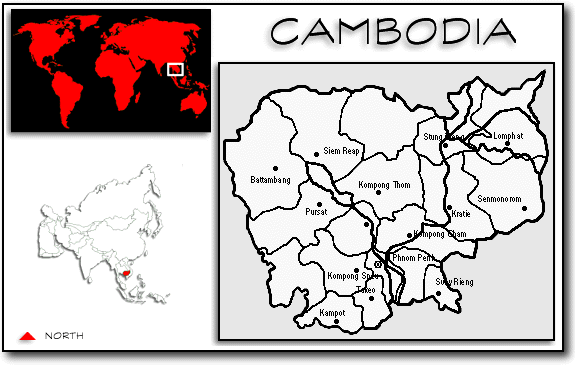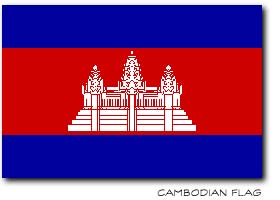Cambodia: Facts, Figures, and Statistics

Geography:
Total Area: Approx. 69,900 sq. miles (181,035 sq. km.). This is slightly smaller than the state of Oklahoma.Location: Southeast Asia; bordered by Thailand, Laos, Vietnam, and the Gulf of Thailand.
Population (2004 Estimate): 13,107,000
Capital: Phnom Penh
Largest Cities: Phnom Penh, Battambang, Sihanoukville (Kompong Som), Siem Reap, Kompong Cham, Kompong Thom
Largest Lake: Tonle Sap
Major Waterway: Mekong River
Mountain Ranges: Cardamom, Dangrek
Highest Point: Phnom Aoral, 5,948 feet
Climate: Tropical, with two seasons, Rainy (May through October) and Dry (October through May). Temperature rarely falls below 80 degrees Farenheit.
Land and Land Usage: Mostly low, flat plains, with some small mountains in the north and southwest. About three-fourths tropical forest; roughly one-fifth arable land. Bulk of remaining land is composed of sandy and infertile soil.
Wildlife: Animals found in Cambodia include monkeys, water buffalo, tigers, elephants, leopards, and crocodiles.
Health and Education:
Infant Mortality Rate: 95.1 deaths per 1000 live birthsLife Epectancy at Birth: 57 years
Literacy: Approximately 67.3% (57% among females, 79.5% among males).(Source: Royal Government of Cambodia Census, 1998).
Water Access: CARE estimates that only 36% of the population has access to safe drinking water. The Cambodian government's 1998 census estimates 29% overall, with 60.3% of urban households and 23.7% or rural households having access to safe water.
Government:
 Type: Cambodia is a Constitutional Monarchy. The government is headed by democratically elected Prime Minister; a National Assembly is composed of 120 representatives. The voting age is 18. The reigning monarch is King Norodom Sihamoni, but his duties are mainly ceremonial. The current Prime Minister is Hun Sen. The first democratically elected leader in recent times, Norodom Ranariddh, was overthrown in a coup staged by Hun Sen in July 1997. Hun Sen was subsequently elected Prime Minister in elections in July 1998, but the elections were severely flawed by a climate of violence and intimidation. Recently, the political situation has stabilized, but serious problems of corruption and impunity remain. Elections in 2003, though still far from perfect, were less violent than earlier polls. Hun Sen once again emerged victorious.
Type: Cambodia is a Constitutional Monarchy. The government is headed by democratically elected Prime Minister; a National Assembly is composed of 120 representatives. The voting age is 18. The reigning monarch is King Norodom Sihamoni, but his duties are mainly ceremonial. The current Prime Minister is Hun Sen. The first democratically elected leader in recent times, Norodom Ranariddh, was overthrown in a coup staged by Hun Sen in July 1997. Hun Sen was subsequently elected Prime Minister in elections in July 1998, but the elections were severely flawed by a climate of violence and intimidation. Recently, the political situation has stabilized, but serious problems of corruption and impunity remain. Elections in 2003, though still far from perfect, were less violent than earlier polls. Hun Sen once again emerged victorious. Economy:
Primary Occupation: AgricultureChief Products: Rice, rubber, wood and wood products, corn, garments, rubies
Monetary Unit: Riel
GNP Per Capita, 2002 $1970 US
Culture:
Ethnicity: Khmer (approx. 90%); Chinese (approx. 5%); Vietnamese (approx. 5%); small minorities of hill tribes, Chams, Burmese, and ThaiReligions: Theraveda Buddhism (95%); Islam; Christian; animism; atheism
Languages: Khmer (95%); some French, Vietnamese, Chinese, and English
No comments:
Post a Comment